Marburg
![]()
The title of this article is ambiguous. For other meanings, see Marburg (disambiguation).
Marburg is the county seat of the central Hessian district of Marburg-Biedenkopf and lies on the river Lahn. For traditional demarcation from Marburg an der Drau, the town was officially called Marburg an der Lahn or Marburg a. d. Lahn until 1974 and then Marburg (Lahn) until the end of 1976.
Marburg is a university town and with 76,401 inhabitants the eighth largest town in Hesse. The city area extends on both sides of the Lahn to the west into the Gladenbacher Bergland and to the east over the Lahnberge to the edge of the Amöneburger Basin.
Marburg has had city rights since the 13th century. Today it fulfils the function of a regional centre in the administrative district of Gießen (Central Hesse). As a larger medium-sized town, Marburg, like six other medium-sized towns in Hesse, has a special status compared to the other municipalities belonging to the district. The city therefore assumes tasks of the district, so that in many respects it resembles an independent city. Marburg has with the Philipps University, founded in 1527, the oldest still existing Protestant founded university in the world, which still shapes the cityscape through its buildings and student life.
The city owes its name Marburg to the fact that the border ("mar[c]") between the territories of the Landgraves of Thuringia and the Archbishops of Mainz used to run here. The most outstanding sights in Marburg are the Elisabethkirche, the Old University, the Landgrave's Castle and the old town below it, which is called "Oberstadt" in Marburg.
.jpg)
Panorama of the core city (spring 2014)

Upper town from the east (October 2008)
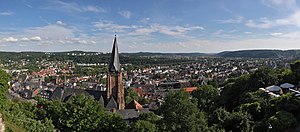
Südviertel and district Cappel in the south (July 2008)
Geography
Geographical position
Marburg is located in central Hesse, roughly halfway between Frankfurt am Main and Kassel, about 77 kilometres as the crow flies from both cities. The neighbouring university town of Gießen is about 27 kilometres to the south.
Marburg is situated in the Marburger Bergland, a south-western spur of the Burgwald, which is interrupted by the valley of the Lahn in a north-south direction. To the west it borders with the Elnhausen-Michelbacher Senke and the adjoining Damshäuser Kuppen directly on parts of the Gladenbacher Berglandes and thus on the Rhenish Slate Mountains, to the east the Amöneburger Becken adjoins, which also has a share in the city's territory.
The highest mountain within the urban area belonging to Marburg is the Störner (412 m above sea level) west of the town proper, northwest of the small district of Dilschhausen. The lowest point is in the south of the town on the Lahn (173 m above sea level).
The largest extension of the main settlement area in north-south direction is about nine kilometers (north of Wehrda to south of Cappel), in east-west direction a maximum of 4 (west of Marbach to eastern Ortenberg) to 4.5 kilometers (western Stadtwald to eastern Richtsberg), but mostly - adapted to the narrowness of the valley of the Lahn - significantly less. To the west of Marburg's Lahn valley depression, parts of the old town and other parts of the town rise up the Marburg ridge; to the east, the Lahn mountains join in, with the university hospital and various institutes at their summits.
The historic old town centre lies to the west of today's town centre, below the Landgrafenschloss (Marburg Castle); the bridge suburb, the former tanners' village of Weidenhausen on the other side of the Lahn, also has the character of an old town. Over the last two centuries, Marburg has expanded from the old town centre downwards into the Lahn valley. South of the castle is the art nouveau quarter Südviertel, west of it is Ockershausen, which was incorporated in 1931. Ortenberg, which is separated from the town centre by the railway line, is located in the immediate east of the core town. In the extreme south-east of the old town area, the high-rise housing estate Richtsberg, which was only built in the 1960s, is located at higher altitudes.
During the territorial reform of 1974, the metropolitan districts of Marbach (northern west), Wehrda (north) and Cappel (south) were incorporated, into which the built-up area of the city merges smoothly. Marbach in particular, like Ockershausen, can now be considered part of the core city, although for historical reasons the district is not administered as an inner city district. Marburg's neighbouring municipalities are, clockwise, starting in the north, the following towns and municipalities: Lahntal, Cölbe, Kirchhain, Ebsdorfergrund, Weimar (Lahn), Gladenbach and Dautphetal.
Geology
→ Main article: Geology of the Marburger Bergland
After the Lahn has taken in the rivers Wetschaft and Ohm south of the Frankenberger Bucht, it turns south and cuts through a mighty, in large areas flat-lying and predominantly forested layer package of the Buntsandstein, which was deposited in the Lower Triassic, near Marburg. The cityscape is therefore determined by the low-lying deposits of the Lahn in the Marburg Lahn valley depression and the heights of the red sandstone rising in the west and east.
The main rock of the Buntsandstein near Marburg is the Middle Buntsandstein, which is about 250 metres thick. Its alternating fine to coarse, reddish quartz sands and sandstones underlie the forested heights of the Lahnberge and the Marburg Ridge. In the western half of the Marburg Ridge, the Lower Buntsandstein predominates.
The sedimentary rocks of the Zechstein, which are about 60 metres thick and underlie the Buntsandstein on the eastern edge of the Rhenish Slate Mountains, are not exposed on the surface in the western part of the city. They were deposited on the eastern edge of the shallow Zechstein sea and consist mainly of copper shale.
A major role in the geological structure of the Marburg area is played by faults which, from the Upper Jurassic onwards and during the Tertiary, dissected the Hessian depression into a fracture clod field and brought rocks of different ages to the same level. The rocks of the Lahn basin and its neighbouring geological structures, known only about five kilometres to the west in the Slate Mountains, were lowered by fracture tectonics and form, a few hundred metres below the surface, the basement of the Zechstein and Buntsandstein below Marburg. They reappear on the earth's surface in the northeast in the Kellerwald.
The Vogelsberg volcanism is related to the fracture floe formation. A few kilometres southeast of Marburg, the Buntsandstein and the layers of the Miocene overlying it are extensively covered with basaltic rocks, which were mined in the Miocene 7 to 20 million years ago.
The central part of the city area is underlain by silts, sands and gravels of the Marburg Lahn valley depression, which are only slightly consolidated. They were deposited by the Lahn, which has cut a valley through the red sandstone and widens considerably a few kilometres south of the town in the less resistant rocks of the Zechstein.
City breakdown
→ Main article: Marburg city division
The city of Marburg consists of the core city and 18 districts with their own local council, which were independent until their incorporation in the 1970s. Ockershausen, which was incorporated in 1931, and Richtsberg, which was not developed until 1963, both have their own local councils and are listed below according to geographical location.
- The left column runs, except for Dilschhausen (Damshäuser Kuppen), from north to south through the Elnhausen-Michelbacher Senke.
- The half-left fissure also follows the depression, but extends eastwards to the western slope of the Marburg Ridge.
- The middle fissure extends from the eastern slope of the ridge, as far as Marbach, eastwards to the western bank of the Lahn (Marburg Lahn valley depression), in the case of Wehrda also to the eastern part of the depression.
- The half-right fissure starts only south (east) of the core city of Marburg and extends from the eastern Lahn valley to the western slope of the Lahn mountains.
- The right column lies on the eastern slope of the Lahn Mountains towards the Amöneburg Basin.
The districts are distributed along the outlined lines as follows:
|
|
|
|
|
The older inner city districts of Altstadt (without Ketzerbach, Zwischenhausen and Roten Graben), Campus-Viertel, Südviertel and Weidenhausen as well as the younger Waldtal district also have local councils.
Statistical districts
→ Main article: List of statistical districts of Marburg
For statistical purposes, Marburg is also subdivided into 33 city districts: the 18 outer city districts and the core city, which is subdivided into 15 inner city districts (of which Ockershausen and the Richtsberg each have two). The nominal core city has (as of 31 December 2016) 45,773 inhabitants, the inner city area supplemented by Cappel, Wehrda and Marbach 61,647, while the village outer city districts account for 12,055 inhabitants.
Boroughs
In addition to the official structure, the city has 18 so-called district communities, which also work on the development of the districts as (partly registered) local history associations on a voluntary basis with the Marburger Stadtteilgemeinden working group. In addition to organising events in a wide variety of areas, these associations take part in planning or contribute to district development with their own efforts, such as the construction of children's playgrounds or allotment gardens. The district communities are called:
- Afföller
- Bathroom
- Bauerbach
- Dagobertshausen
- Ginseldorf
- Gisselberg
- Hansenhaus
- Ketzerbach
- Marbach
- Upper Town
- Ockershausen
- Ortenberg
- Richtsberg
- South Town
- City Forest
- Forest Valley
- Weidenhausen
- Zahlbach
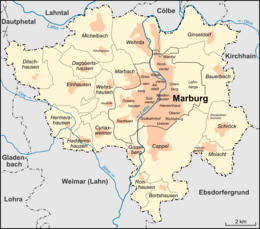
Districts of Marburg
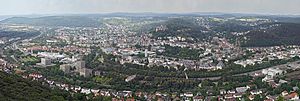
Marburg, seen from the Kaiser-Wilhelm-Tower, Schlossberg in the middle
_am_5._Mai_2016.JPG)
Valley with core city and castle from the Elsenhöhe (May 2016)
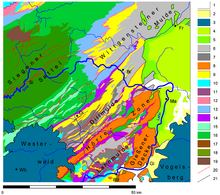
Geological map
Religion
Marburg's religious importance began in 1235 with the canonization of Elisabeth of Thuringia and the construction of the Elisabeth Church. After Rome and Santiago de Compostela, Marburg was one of the most important European pilgrimage sites at that time. It continued with the Reformation, which was supported and implemented by Philip the Magnanimous, and the associated construction of the world's first Protestant university. The university in turn gave rise to the wide religious spectrum that can be found in the city today.
In 721, Boniface built a small monastery and a new church below Amöneburg Castle, or rededicated an Iro-Scottish predecessor church. However, Marburg did not have its own parish until 1227, when Marburg became a city. The resident parish had previously been a branch of the mother church in Oberweimar. After the death of St. Elisabeth, the Teutonic Order took over her hospital and built the Elisabeth Church in her honour. Until the Reformation, spiritual life was dominated by Catholicism, as evidenced by the presence of numerous religious orders such as the Brothers of the Common Life ("Kugelherren"), the Augustinians or the Franciscans (Barefoot Friars). With the Reformation, Landgrave Philip the Magnanimous adopted the Protestant doctrine and at the same time banned Catholicism. It was not until 1788 that Catholic teaching was again permitted in Marburg.
Christianity
The Protestant parishes of Marburg belong to the Marburg church district in the Marburg parish within the Protestant Church of Kurhessen-Waldeck. They own important church buildings in the core city, including the Elisabethkirche, the Pfarrkirche St. Marien and the Universitätskirche and also old village churches in the outlying districts of Bortshausen, Cappel, Dilschhausen, Elnhausen, Hermershausen, Haddamshausen, Michelbach, Moischt, Ronhausen, Wehrshausen and Wehrda.
The Roman Catholic parishes belong to the diocese of Fulda. With the territorial reform in 1974, the three Catholic villages Ginseldorf, Bauerbach, Schröck from former Mainz territory came to Marburg.
Free churches and Protestant communities have existed in Marburg since the 19th century.
The Evangelical Free Church congregation was founded in 1840 and is thus one of the oldest German Baptist congregations. Its community centre is the Uferkirche, which was inaugurated in 1957. Since 1958, it has also had a student dormitory.
Of the so-called old denominational churches, only the Independent Evangelical Lutheran Church is represented in Marburg. The Christus-Treff Marburg is an ecumenical fellowship in which both Free Church and Evangelical-Lutheran Church as well as Catholic leaders work together. As a whole it is part of the Protestant Church and is integrated into the EKD through the network "TGG" ("Treffen Geistlicher Gemeinschaften").
Five Protestant communities work in Marburg. They belong under the umbrella of the Evangelischer Gnadauer Gemeinschaftsverband e. V. This is an umbrella organization of German community movements and works within the Protestant regional churches in Germany. Also in Marburg there is a group of German Jesus Freaks, the Catholic Apostolic Community and the Brethren Community.
Other religious communities in Marburg are the New Apostolic Church and the anthroposophical Christian Community.
Christian communities in Marburg
Communities within the Protestant regional churches (Gnadauer Verband)
- Evangelical Community Cappel
- Evangelical Community Marburg-Ortenberg
- Evangelical Community Marburg-South
- Evangelical Community Wehrda Hebron Community
- Evangelische Stadtmission Marburg (Chrischona congregation)
Association of Protestant Free Churches VEF
- Evangelical Free Church Congregation, Baptists, Shore Church
- Evangelical Methodist Church, EmK, Christ Church
- Anskar Church Marburg, Evangelical Free Congregation
- Free Evangelical Congregation, FeG
- Seventh-day Adventists, STA
- Christian congregation, Light of Hope, Russian-German congregation, in the BfP
Ecumenical Communities
- Christ Meeting
Old denominational churches
- SELK, Independent Evangelical Lutheran Church, MR
Catholic church in Marburg-Kernstadt
- St. Johannes ("Kugelkirche"), catholic
- St. Peter and Paul, Catholic
- Liebfrauen, Catholic
Catholic church in Marburg districts
- Wehrda St. Martin (to St. Peter and Paul), catholic
- Cappel St. Franziskus in connection with Liebfrauen, catholic
- Bauerbach/Ginseldorf (Bauerbach parish office)
- Schröck/Moischt (parish office Schröck)
- Bortshausen, Ronhausen (St. Francis Cappel)
- Gisselberg, Cyriaxweimar, Haddamshausen, Hermershausen, Wehrshausen, Elnhausen, Dagobertshausen, Michelbach (to St. Johannes Kugelkirche with branch church in Wenkbach)
- Dilschhausen
Protestant church in the city of Marburg (core city)
- Elisabeth Church, Protestant
- Evangelical Church at the Richtsberg to MR
- Lukaskirche, Protestant
- St. Mary's Lutheran Parish Church
- Markuskirche, Protestant (Marbach)
- Matthäuskirche, Protestant, Ockershausen
- Pauluskirche, Protestant
- University Church, Protestant
Protestant church in the districts of Marburg
- Bauerbach/Ginseldorf (Bauerbach parish office)
- Moischt/Schröck (Wittelsberg parish office)*
- Bortshausen, Ronhausen (parish office Cappel)
- Cappel
- Gisselberg, Cyriaxweimar (parish Niederweimar)*
- Hermershausen/Haddamshausen (parish office Oberweimar)*
- Wehrshausen (Parish Elnhausen)
- Elnhausen/Dagobertshausen (Elnhausen parish office)
- Michelbach
- Dilschhausen, Dilschhausen (Parish Weitershausen)*
- Parish office outside Marburg
Ecumenism in Marburg
The Association of Christian Churches in Marburg (ACK) is an association of Christian churches and communities for the promotion of ecumenical cooperation and the unity of Christians and the churches. Conversation, meetings and church services promote mutual understanding.
The Evangelical Alliance is an alliance of Christians from various Christian churches, communities, Christian groups and ministries. The work of the Evangelical Alliance Marburg is carried out by a working group, which serves the exchange, the common prayer and the perception of common responsibility. Evangelistic, pastoral and diaconal activities are planned and accompanied.
These two inter-parish ecumenical working groups bring people of different Christian backgrounds together for the common Pentecost Monday service, the Alliance Week of Prayer at the beginning of the year; for services for the unity of the church.
Central office of Christian works with seat in Marburg
- Head office of the German Community Diaconal Association DGD. The German Community Diaconal Association (DGD) with its headquarters in Marburg is an association of diaconal-missionary institutions in the Evangelical Gnadau Community Association with diaconal institutions in Germany, Japan, the Netherlands, the USA and Brazil.
- The Marburg Mission is an evangelical mission organisation based in Marburg with branches in Japan, Taiwan, Thailand, East Africa, Brazil, Spain and Russia.
- Headquarters of the Student Mission in Germany SMD. The SMD is a Germany-wide network of Christians in school, university and academic professional world (founded in 1949 as Studentenmission in Deutschland e. V.).
- Compassion Germany is the German branch of Compassion International, one of the largest Christian children's charities in the world.
Christian training centres
- Department of Protestant Theology at the Philipps-Universität Marburg
- Tabor Evangelical University
- Catholic Theological Seminary
- Marburg Education and Study Center (MBS)
Judaism
→ Main article: Jewish community of Marburg
There was a Jewish community in Marburg for the first time in the Middle Ages. A larger number of Jewish families lived in the Judengasse in the first half of the 14th century. After expulsions in the 14th and 16th centuries, the community grew to over 500 members by the 20th century. Already at the beginning of National Socialism many Jews moved away or emigrated. 77 Jews who remained in Marburg were deported and murdered in 1941/42 to Riga and Theresienstadt respectively and to extermination camps in the East. In the 1980s a new Jewish community was founded. On 26 November 2005 a new synagogue was inaugurated in Liebigstraße. In 2006, about 350 people belonged to the congregation. On 28 November 2010, the Jewish community consecrated the first new Torah scroll since the Shoah.
On the site where the synagogue once stood, destroyed by the Nazis, there is now the "Garden of Remembrance". A copper model shows the appearance of the synagogue, a stone with an inscription explains the significance of this place.
Islam
According to official figures, about 5000 Muslims live in Marburg. Since 1986 Marburg has a mosque, the Omar-Ibn-Al-Khattab-Mosque. It is supported by the association "Orientbrücke Marburg e. V." This association belongs to the Islamic Community Germany e. V. (IGD). (IGD) and is thematized like this in the report for the protection of the constitution of the federation. The IGD was the original sponsor of the mosque. It is considered the German headquarters of the Muslim Brotherhood. The links of this organisation reach as far as groups suspected of supporting Islamist terrorism. In 2002, the association "Islamic School" was founded, which was renamed "Orient Bridge". Since then, the Marburg mosque has been formally independent of the IGD. A Muslim cemetery is located in a section of the municipal cemetery in the district of Ockershausen.
On 21 June 2013, the foundation stone was laid for an Islamic cultural centre with a mosque in the "Bei St. Jost" neighbourhood. In addition to the prayer room, a cafeteria, a delicatessen, a library and multifunctional rooms are to find space in the building; everything is to be open to the public. The construction costs of about 1.8 million euros are financed by donations.
In addition, there is a congregation of the Ahmadiyya Muslim Jamaat in Uferstraße and the Dar Al Salem Mosque in Friedrich-Ebert-Straße. The latter was the target of an arson attack on 10 November 2017.
Other religions
There is a congregation of Jehovah's Witnesses and a Bahá'í congregation in Marburg. Until shortly after the year 2000 there was a headquarters of Universal Life in Biegenstraße.
With a Shambhala centre, Marburg is also one of the larger European Buddhist centres. The community consists of about 50 to 120 practitioners. It is a member of the German Buddhist Union, is listed by Shambhala International and is a member of the European Buddhist Union through Shambhala Europe. In addition, there are a number of other religious groups, which came to Marburg not least through the university.
A Wicca coven is documented for 1995. Marion Näser-Lather conducted theme-centered interviews with Wiccans from the Marburg area in 2012.
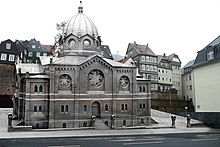
Same view with photomontage of the copper model
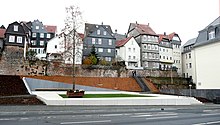
Garden of Remembrance
Search within the encyclopedia